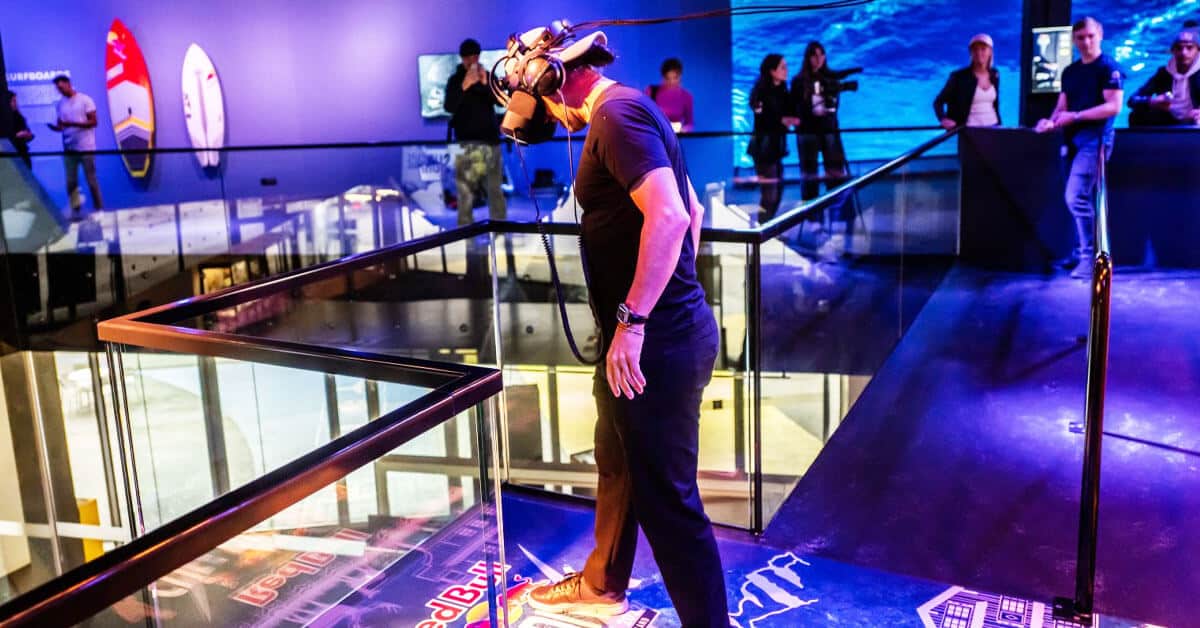Immersive technology has long been one of the most important trends within the more significant tech sector. But like the Internet before it, the growth of this technology has made it a part of almost every professional and personal sphere. While immersive tech is still relatively new, there has never been a better time to learn about these fantastic cutting-edge concepts.
What Is Immersive Technology?
Immersive technology describes myriad ways to create, display, and interact with new experiential content. Some metaverse companies create technologies like VR headsets that fully immerse the user in a new digital reality. But devices like the Apple Vision Pro can overlay digital elements over the physical world to extend reality. Immersive tech lets you feel like you’re part of simulated environments. You could interact with the set inside an immersive theater or even feel the dashboard’s controls when behind an immersive air control dashboard. These technologies mesh your sense of sight, hearing, and touch with virtual environments.
9 Types of Immersive Technology
Immersive technology is growing at a rapid pace. But at the moment, there are nine main categories to explore. Each of the following brings with it some fantastic new experiences.
360
360 is one of the most easily recognized forms of immersive technology. This is partly thanks to the meager cost of entry for 360 content generation and playback. Your phone can probably take a 360-degree image using variations on the “photosphere” concept. And this widespread availability has led to lots of 360 content on YouTube, Facebook, and similar socially driven networks. However, that’s not to say that all 360 content is user-generated. It’s also proven itself as an excellent medium for various brand-sponsored events. For example, companies could give users a full 360-degree view of events.
Video: Trip to Tokyo, Japan. Aerial 360 video in 8K
Holograms
Holograms are 3D projections that can be seen from any angle as physical objects. They can be static images or fully animated. And amazingly, a full holographic projection can even be seen without special glasses, apps, or cameras. This technology benefits academic subjects, which would typically be difficult to study live. For example, medical students are using holograms in mixed-reality environments. Likewise, metaverse brands are always finding applications within the entertainment industry, and holograms are no exception to that rule. Performers are beaming themselves out to the world and even mobile games.
Video: German Circus With Hologram Technology 2019
Virtual Reality
Virtual reality is another of the more familiar forms of immersive technology. Users don a VR headset that replaces the physical world with a virtual one. There’s also a lot of other VR hardware that expands it into new levels of immersion. For example, you can use VR masks to simulate smell and gloves for touch. Treadmills can even let you run within VR systems. Many venues, like metaverse events, have even expanded to allow for VR attendance. Learn more about VR’s hardware, software, and culture in the article Virtual Reality; Discover VR, Its Components, Technology, and Players.
Video: VIVE Flow – Mindfulness with immersive VR glasses | VIVE
Augmented Reality
Augmented reality (AR) is arguably the most common form of immersive technology. Most people’s phones can handle augmented reality. Even people who don’t know the term augmented reality may have used it before. For example, many metaverse games use AR to deploy digital entities or items into the physical world. Pokémon GO is one of the most easily recognized examples of this type of AR game. AR is also incorporated into special glasses. Find out more about the AR side of immersive tech in the article Augmented Reality; Learn About AR Tech, Use Cases, Devices, and More!
Video: A New Augmented Reality for American Manufacturing
Mixed Reality
Mixed reality (MR) is a newer and less well-known form of immersive technology. It’s similar in many ways to augmented reality. But mixed reality typically has a higher level of immersion thanks to more powerful hardware. For example, MR typically uses a headset, while AR uses 2D devices like smartphones. MR’s more powerful foundation means integrating digital elements into the physical world. MR elements are closer to holograms than 2D overlays. You can see the beginning of this new technology in the article Mixed Reality; Everything to Know About MR Technologies.
Video: Introducing Apple Vision Pro
Extended Reality
Extended reality (XR) describes technologies that can extend your view of reality. This includes immersive technology that replaces your view of the physical world with a new virtual universe. But it also includes technologies like augmented reality that add a little digital flair to the physical world. Devices like the Microsoft HoloLens are apparent examples of XR. But anything that merges the physical and digital divide, like an NFT, can also be seen as part of the larger world of XR. Discover how XR changes everything in the article Extended Reality; How is XR Changing the Digital World?
Video: VIVE XR Elite – Thrills and Wonders Where Realities Meet
Telepresence
Telepresence is similar to augmented reality but distinct in its focus on transporting users to another location. Telepresence is most commonly used to control drones or similar robotic devices. But it’s not just about sightseeing. Telepresence can also give people a physical presence at remote events. For example, you could use telepresence with a robot to be present at an office party on the other side of the planet. But it can also extend the user’s presence into totally new forms. For example, you could use telepresence with construction equipment and feel like you’re crushing concrete.
Video: Holographic telepresence: the telepresence of the future
Haptics
Haptics, more commonly known as “kinaesthetic interaction” or “3D touch”, differs slightly from most immersive technology. Haptics differ because it’s entirely focused on the various forms of tactile feedback. Basically, it’s the way people “feel out” the world around them. This includes creating pressure, movement, and vibration. Haptics will be one of the main ways people interact with computing paradigms in the future. It’s how you can feel digital interfaces within the physical world. And the concept is equally important in any future computing system, whether that’s an implementation of new spatial computing concepts or the metaverse.
Video: Haptic Technology Demonstration – with Danielle George
FPV Drone Flight
FPV drone flight is a form of immersive technology that combines unmanned aerial vehicles (UAVs) with wireless camera feeds. This is piped to display devices like headsets or goggles. However, even phones can be used. It creates a fully immersive atmosphere where the user sees the drone’s environment through a first-person viewpoint. When using headsets, it essentially feels like seeing the world as if you were personally flying through the air rather than the drone. However, this can also be a little disorienting. As such, people are advised not to let it get out of their line of sight.
Video: Epic FPV Drone Flying UK!
5 Immersive Technology Use Cases
There are a virtually unlimited number of ways to use immersive technology. But at the moment, the following have proven themselves especially compatible with this new frontier.
Training
Much evidence has made it clear that immersive technology can vastly improve training. This means different things for different fields. But immersive tech will generally improve retention and speed up the learning process. One of the most readily apparent benefits is that this technology can replicate a work environment. Employees can get fully safeguarded, hands-on training in the various areas they’ll be working in. This means that people can practice otherwise dangerous procedures or situations in a safe environment to be ready for them in the real world.
Video: Training for the skies with a hyper-realistic XR simulator | FlightSafety International x Varjo
Education
Immersive technology is also becoming a more common sight within the educational sector. It can create more engaging learning experiences and increase students’ understanding and retention of new information. Virtual reality, augmented reality, and mixed reality have all proven themselves as powerful tools within an educational context. At the simplest level, these tools can provide engaging edutainment that can be enjoyed by an entire family outside of the classroom. But you’ll also find immersive tech used in universities and higher levels of education. What’s especially impressive about this technology is its sheer versatility in covering every educational subject.
Video: The Impact Will Be Real
Marketing & Communications
Immersive tech is a fantastic tool for companies to build their internal capabilities. But tech is also an ideal way to communicate with clients and customers. Additionally, it’s a fantastic way to catch the general public’s attention and gain new customers. The ubiquity of smartphones means that almost everyone has access to augmented reality. Likewise, most people are on social media. This presents an effective way to easily push immersive tech out to the public. This can get people’s attention and prompt new engagement with brands. And it can also help to strengthen brand messaging.

Image attribution: Lenslist
Retail & E-Commerce
Customers’ inability to try before buying is a big problem for retailers. For example, customers might skip buying furniture that would look great in their homes. Or conversely, the customers might wind up buying and returning furniture that doesn’t suit their style. But immersive technology offers a solution to that problem. Companies like Amazon and Ikea let customers try out products through AR. And platforms like Instagram and Snapchat are doing the same for fashion. People can use those platforms for “virtual try-on.” Doing so allows them to check how different makeup or headgear looks.
Video: Amazon AR View: Shopping for your home? Try AR view.
Gaming
Gaming and immersive technology have been connected almost from the start. This has caused some issues with the use of immersive tech in other fields. The connection with gaming is a little too strong in many people’s minds. However, while that misconception has faded, the link to gaming is still going strong. And immersive technology has had some amazing implementations within games. For example, Pokémon GO’s AR caught the world by storm. And PlayStation VR brought virtual reality to a new audience. On top of that, VR arcades are making it easy for the average person to see cutting-edge VR.
Video: Gran Turismo 7 – Bella Learns to Drive | PS VR2 Games
2 Real-Life Examples of Immersive Technology
If you’re wondering how the theory of immersive technology works out in practice, you’re in for a treat. As with use cases, there are many real-life examples to look at. But the following are some of the most notable examples of real-world immersive technology.
The Giza Project
One of the most interesting examples of education-related immersive technology comes from Harvard University. The world-renowned institution has collaborated on a project designed to educate students on both embedded immersive content and the pyramids of Giza. The Giza project allows students to visit the ancient pyramids through virtual 3D mapping. It’s a precious technique since many passages are hard to access. VR is the only practical way to do so. The fact that students can access those areas also opens them up to a more in-depth education on the reasoning behind the pyramid’s design.
Video: DIGITAL GIZA: Giza 3D – Tour of the Mastaba Tomb of Nefer (G 2110)
FundamentalVR – Fundamental Surgery
Immersive technology is often at its best when it combines multiple forms into a singular whole. And the Fundamental Surgery platform is a fantastic example of that principle. It merges VR with haptic technology to offer medical training to healthcare professionals. It’s a scalable, collaborative, and portable system for effective training. What’s more, it can offer all of that to multiple healthcare professionals at the same time. The system is further enhanced by the fact that it supports standard VR devices alongside the precision of Haptic VR. And clinical research has even demonstrated that VR training can shorten the learning curve.
Video: Fundamental Surgery – Total Knee Arthroplasty
Immersive Technology and VR Within Industrial Sectors
The deeper metaverse meaning is centered on merging different worlds. This isn’t just about the digital and physical worlds. Immersive technology also works to bring different methodologies into various professional spheres. VR, in particular, has proven well-suited to the challenge. Fields like construction that have relied on abstracted visualizations can now display virtual mockups before even rolling out the equipment. Tourist destinations can give VR tours. And even fitness centers can provide invigorating or relaxing environments for members. Discover how VR’s changing professional sectors in the article Virtual Reality Industries; An Overview of All Sectors Using VR.
Immersive technology is still relatively new, but it’s quickly becoming a part of every profession. And you now have the tools needed to stay on the cutting edge of the new immersive tech currently being developed.



Leave A Comment